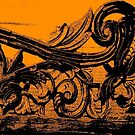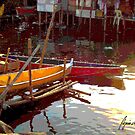Coming from the fourth generation from the lineage
of Gen. Emilio F. Aguinaldo, people expect me to know much about this house
which was built in 1845 by my great great grandparents, Trinidad Valerio Famy
and Carlos Jamir Aguinaldo, a former gobernadorcillo of the town of Kawit. The
house was originally a nipa thatched and timber structure where two other
former town mayors of Kawit were born- Crispulo Aguinaldo (June 10, 1864) and his
younger brother Emilio Aguinaldo (March 22, 1869).
 |
| Trinidad Valerio Famy, Gen. Aguinaldo's mother. |
 |
| Hilaria Reyes Del Rosario, Gen. Aguinaldo's first wife and our great grandmother. |
As a frequent young visitor, I knew then that there
was an important occasion that went on. Surreal colors of blue, red and white
flooded my attentive eyes and my ears rattled with echoing music that seemed to
come from several big toy-like “torotot”. They called it “musiko.” Also, old
men in seemingly faded blue uniform would always rub my spiky hair and give me
a strange smile as they talked to my father.
I have met a lot of old folks and I thought I have
met the General but then I realized it was our Lolo Miling (Emilio Jr) who had
often offered me orange soda. He was seated on a swivel chair that had the
sculpture of the head of a Carabao as a back rest and that was placed against a
huge oval dark cabinet at the ground floor. My father Carlos, probably
realizing I may have mistaken him for the General, explained that he is my
grandfather Miguel’s younger brother.
 |
| Miguel R. Aguinaldo, the eldest child of Gen. Aguinaldo, our grandfather. |
Strange it may seem but all I remember as a child was the dark ground floor, the carabao and the once ornate tomb at the backyard. These occasional visits later would have an impact on my teenage years as I kept coming back to the house as a volunteer and to assist former curators Tita Cora Andrade and later, my aunt Linda Aguinaldo and the staff on commemorative events. Little did I know that someday and somehow I shall be at the helm of overseeing the preservation of this house which my great grandfather donated to the national government a year before his death in 1964.
Now given the task of writing an original article
about this house which became a National Shrine on June 18, 1964, I found it
difficult for so many ideas have been written and published about it. So what
else is new? I thought.
As such, this personal narrative, I hope,
brings freshness to this article as I also struggle to explore more about the Shrine,
the Home of Philippine Independence and the origin of our illustrious and
adversely written about ancestors.
As Carlos Aguinaldo's family grew, the house was
reconstructed as a bahay-na-bato or stone house built with limestone and panels
of capiz windows that were probably fabricated by local folks since the stretch
of Marulas barangay street (east from the house) were dotted with capiz shell
sellers and sash factories until the 80s. The house, located along the Calle Real
or main street, was also home to seven other siblings Primo, Benigno, Esteban,
Tomasa, Crispulo, Ambrosio and Felicidad. Gen. Aguinaldo was the youngest among
the male.
I can imagine such a big family of eight living in a
sprawling garden and a farm comprising an area of more than 25 thousand square
meters. It is in this property that the Aguinaldo siblings and other children,
especially the young Emilio Aguinaldo played games like kalahuyo, sopo, kalderon,
batikobra, piku-piko, San Anton and tubigan. They also loved gardening. The young Emilio
recalls in his diary- “ Pagalingan kami
ng mga halaman. Sa aming paglalaban,
bagaman pinakamunti ang aking lahuerta, ay pinakamagaling naman ang mga pananim
ng mga gulayan, bakit totoong mahilig ang loob ko at masipag akong magdilig
kaysa aking mga kapatid.” Each would maintain a small garden plot and show
off their skills. Though his is the smallest plot, the young Emilio would come
up with the best produce.
The General’s love for gardening, it is in the
genes, I guess, may be attributed to his father Carlos, who loved to plant
chico, mango, granada (promegranate), lukban (suha), atis and other
fruit-bearing trees. Many of these trees still abound in the garden.
The “silong”or ground floor, which now is a museum,
was used for storing grain and other produce since farming and sugar milling,
according to notes by the General, were was once our ancestors source of
livelihood. It was also used as storage for old family stuff like the other
“silong”” under the family wing (east) where my aunt Zeny A. Pobre was born
during World War II.
Aside from relics or objects which were part of the
estate donated by the General in 1963, other prominent features of the ground
floor are the family’s two duckpin bowling lanes, the old indoor swimming pool
beside it and the bomb shelter which was once a short well that had a tunnel
extending up to the church of Kawit. No one, however, has come up with documentary
evidence validating the existence of the length of the tunnel.
The ground floor, which once looked spacious, is
dotted with hardwood posts that support the main hall and other rooms of the
second floor. The exposed beams supporting the wood slabs of the floor of the
second level and laid out in seemingly even patterns provide artistic flair as
ceiling.
An impressive ipil wood staircase facing north invites
guests to ascend the second floor that consists of spacious sala or hall, a
master’s bedroom, family and formal dining room with windows overlooking the
west garden, a meeting hallway and a kitchen that leads to an open azotea or
patio that was once a garden for potted herbal plants and where goods or
supplies where dropped off.
To the left of the vestibule is a corridor that
leads to the family wing. Found along this wing are the bedrooms of our three grandaunts,
Carmen, a teacher who lived in the house until 1986, Maria, and Cristina.
As fashionable in the early 20th century, the
furnishings and accessories in these rooms are mixed European, Chinese and
Filipino. Art Nouveau and Art Deco – whiplash, stylized Philippine flora and
geometric images - are evident styles among the furnishings that consist of
exquisitely carved dressers, cabinets, side tables and writing tables.
A balcony facing the Marulas River is found at the
far end of the family wing. Playfully called by Gen. Aguinaldo as “Balcony of
Sinners” or “Balkon ng mga Kasalanan”, the balcony was once a corner for late
afternoon snacks and other family gatherings. It is enclosed by wood fretworks
of creeping vines in double and triple arch panels and wrought iron balustrade.
The balcony’s floor is accentuated by cement tiles in gray, white and black
stars motif.
 |
| The Balcony of Sinners in a 2001 photo. |
A
prominent structure of the house is the five-floor tower which was also added between
1919 and 1921. It was when the late general began to receive pension from the
government.
The
first floor of the tower is a mezzanine library which overlooks the grand sala with
an alcove that doubles up as a band stand. This was where musicians played as
formal gatherings were held down the sala or main hall.
A
few set of steps takes one to the bedroom of Miguel, the oldest son of the
General and my grandfather who was a pilot. The room was also once used as a study
by the late Ambassador Jose Melencio, the General’s son-in-law. It was fondly
called by my aunt Alice A. Dizon as “dormitory ” since it could accommodate a
lot of family friends and extended family members. Facing the calle real, the
room also has a view of the fish ponds and the rest of the shoreline of Kawit.
As such, the sea breeze, according to old family friends, provides one a sense
of relaxation. One could simply imagine what he gets as he lies down the
plantation divan found in this room.
Next
is the bedroom of Emilio Jr, the youngest son who was a banker. A smaller room,
it was also used by Gen. Aguinaldo when he wrote his memoirs of the revolution.
The room is joined by an open concrete terrace that has a commanding view of
the Manila Bay, the shoreline of Cavite City and the Naval Base. With the hook-shaped landscape of Cavite City
( Cavite Puerto) evident from the terrace and its proximity to Manila, one
realizes how crucial Cavite is to the colonizers who were based in the Capital.
It was truly an excellent site for shipbuilding and a strategic point for the
military, specifically, the Spanish
Navy.
A
ladder-like steep stairway, leads finally to the sixth floor, a viewing deck
enclosed by capiz windows. Those who are brave enough to climb up the spot
would understand why it was the General’s favorite spot. A visitor is always in
awe at the panoramic scene of the mountains of Bataan on the west, Batangas on
the south, Laguna on the east, and the cityscape of Metro Manila with the
landscape of Rizal as the backdrop on the Northeast. It has become a blogger
and a photographer’s best-loved spot too.
This
imposing tower structure with windows and a terrace overlooking the coast, the
Cañacao Bay and the Manila Bay is derived from the General’s love for the sea.
Down
from the four narrow set of stairs of the tower, the next spectacle is the
grand hall. It is in this hall that Julian Felipe played the draft of the Marcha
Filipino Magdalo to the generals of the Revolution on the eve of the declaration
of Philippine Independence and which was later changed to Marcha Nacional
Filipina, the National Anthem.
 |
| Maria Agoncillo, second wife of Gen. Aguinaldo, posing along the Mirror of Truth or "Salamin ng Katotohanan". |
Immediately
from the vestibule, what one sees is a reflection of himself since a big mirror
encased in narra and lanite crown and carved elaborately with vines on trellis,
a buffet sideboard, actually, welcomes him. The General fondly referred to it
as “Salamin ng Katotohanan” or Mirror of Truth. Visitors giggle as many would
actually stand before it and find out what that truth is all about.
At
the end of this rectangular hall is the historic window where Philippine
Independence was first declared on June 12, 1898. A balcony with the design of
a carabao carrying it had been added in the 1920’s, a year after the
prohibition of the display of the Philippine flag was lifted by the US
Government. Now popular as the Independence Balcony, it has been used by government
officials during Independence Day celebrations. Beneath the balcony and the carabao is the
spot where the General once wanted to be buried according to one of my uncles.
Opposite
the balcony, in the main hall, is an alcove with a bench set on a slightly
elevated platform referred to as Seat of Justice since it is believed that this
was where valuable decisions are made during the revolution.
The floor that is made of
Philippine hardwood is a sight to behold. It consists of wood panels that are
laid out like mosaic trapezoids reminiscent of the flag. The flag inspiration
is actually evident in every nook and cranny of the house. Even the pillars
along the formal dining room were designed in such fashion. A surprising
feature of walls of the main hall is the various pull-down ledges with clam
shell woodcarving that are used as a narrow shelves for potted plants and other
utility functions.
When a visitor looks up the
ceiling, he learns the story of our heroes’ aspiration for independence. The
ceiling has three panels. On the first panel, carved furled flags and a dove are
installed conveying the Philippines’ quest for membership in the League of
Nations. The letter carried by the dove bore the information that the
Philippines was ready for self-governance. The second panel is the eight-rayed
sun ( Lei Marcial) depicting the revolt of the first eight provinces that was
placed under martial law by the Spanish government. The third symbol near the
independence balcony is “Inang Bayan” or Mother Philippines liberated from the chains
of oppression, a wood masterpiece by Tampingco.
Facing the grand hall is the
master bedroom where an altar is found, a place where the Aguinaldo siblings
would pray the “Trisagio” every Sunday
and others on weekdays like the “Gozoso”, “Doloroso”, and “Glorioso”. Kneeling
on the hardwood floor, the young Aguinaldo would actually fell asleep while
praying!
Also found in the bedroom are
secret passageways like the small balcony that leads to a secret door
camouflaged as a hat rack fronting the staircase, a door on the west side
towards the kitchen and family dining room, and a built-in cabinet along one of
the windows facing southeast. There is also a door as entrance down to the
swimming pool and the bowling lanes just along the bathroom that is laze with authentic
English tiles, and enclosed by escalado panels. The passageways and other
hidden compartments were actually designed not out of cunningness but simply to
maximize use of space.
From the master bedroom down
the hall on the right is the small reception room cum music room since this is
where the family radio console is kept and where Aguinaldo once entertained
media personalities and other numerous visitors. The room, facing the Calle
Real is the favourite spot where the General played chess. Along the windows
that are ornately designed with green glass panels, a chess table and two
romanesque chairs used to quietly lay on that corner. Another wall panel hides
a door that opens to a small restroom and to the upper floor of the house.
On the west side of the grand
hall is the formal dining room. The family’s special guests who usually dined
on the large wooden tables (as big as 2.80 meters in diameters) during important
occasions (like the wedding reception of Cristina Aguinaldo and Federico
Suntay) at the formal dining room possibly could not help but move their faces
towards the ceiling. A huge and precise relief map of the Philippines with
Cavite painted red adorns the ceiling. Facing west, the room’s French windows
have glass lunettes that are painted with human figures of Hilaria del Rosario,
the General’s three daughters, and second wife, Maria Agoncillo.
 |
| Wedding reception of Cristina Aguinaldo and Dr. Federico Suntay at the formal dining room. |
 |
| Relief map of the Philippines installed at the ceiling of the formal dining room of the Aguinaldo Shinre. |
The adjoining room is the
family dining room where a rectangular narra table for around fourteen persons
stands at the middle. When lifted, the table reveals a passage down the bomb
shelter. Near this room is, of course, the kitchen where one would find the
built-in ice storage or boxes and the pugon or stove that has eight burners.
Since it is such a big family of local government leaders who are used to
entertaining large gatherings, the stove could accommodate eight recipes at one
time. Installed along the pugon are water pipes from a water tank that is directly
linked to the bathroom of the masters bedroom. It is actually a source of hot
water for the bathroom.
Between the kitchen and masters bedroom is a
sky-lighted doorway which the general calls Veterans Hall. Here, the general used to exchange stories
with the veterans of the revolution up to the wee hours of the night. Installed
in this hall are long hardwood benches on both sides with secret compartments that
may have been used to hide valuable documents.
From the kitchen, a huge door
opens up to the patio. This is where revolutionary leaders once mapped out their plans while a look-out
atop an old sampaloc or tamarind tree scan the surroundings for signs of enemy
movement from the Manila Bay. The patio is bordered by concrete sculptured
panels as railings. The panel along the west side retells the story of “the
heroism of Gregorio del Pilar at Tirad Pass, the revolutionary headquarters in
San Miguel, Bulacan, Admiral Dewey’s battleship Olympia and the capture of
Aguinaldo.” Prominent features of the said panel are the mythical sun with
three stars, the head of a carabao, the inscription VR (Veteranos de la
Revolucion) and KKK.
As an artist who dearly loves
anything vintage, I have always been fascinated by the interiors which are
mostly narra, tanguile, yakal, camagong and ipil. The texture and color of the
hardwood, fused with natural light, provides many videographers and
photographers fondness and amazement. The interiors are ornately carved in various
styles in rococo, baroque, gothic and in other unique styles. There was an
infusion of locally-inspired Filipino symbols like the anahaw leaves,
sampaguita flowers, paco or ferns, and masonic elements. These carvings, we
were told, were rendered by Betis and Macebebe artisans who remained loyal to
the General. Old Kawit folks even said that these artisans did not even ask for
compensation from the General- the spirit of Bayanihan! They were simply passionate
in helping execute the design thoughts of Gen. Emilio F. Aguinaldo, and his
cousins Baldomero Aguinaldo and Benedicto A. Ilano.
Gen. Aguinaldo readied the
house as a monument for the revolutionary heroes and as such, the architectural
details and interior of this house retells the story of the revolution. The house,
a “bahay-na-bato”or “malaking bahay” turned somewhat Victorian, grew from the
creative imagination and self-expression of three Aguinaldos who are not even
designers or architects nor jet-setting travellers. And I am certainly proud to
have come from that lineage!























No comments:
Post a Comment